Professor Zhifang Chai: Scientific contributions and achievements
Prof.Zhifang Chai, born in October 1942, is a radioanalytical chemist working at the Institute of High Energy Physics, Chinese Academy of Sciences and Soochow University.He graduated from Fudan University in 1964.As an Alexander von Humboldt Foundation fellow, he worked at Cologne University, Germany from 1980 to 1982.He is closely engaged in nuclear energy chemistry and nuclear analytical techniques (NATs), and has authored or coauthored over 430 papers in peer-reviewed journals and 10 books.He is a titular member of IUPAC, a fellow of RSC and many other domestic and international scientific communities.In 2005, he received the George von Hevesy Award – the premier international award to honor his outstanding achievements in radioanalytical and nuclear chemistry.In 2007, he was elected as a member of the Chinese Academy of Sciences (CAS).
He was the director of CAS Key Laboratory of Nuclear Analytical Techniques.During his over 50 years of scientific researches,he has been devoting to the development and application of NATs in diverse fields, from geochemistry and astrochemistry, to life science, environmental science, nutrition science, food security, and archaeological science,etc.He also contributed greatly in fostering and supporting the emerging research field of biomedical effects of nanomaterials and nanosafety and metallomics.Last but not least,he made great contribution to the development of nuclear-energy radiochemistry.
1.The pioneered application of NATs: from NAA to MAA
Since 1970s, Prof.Chai and colleagues pioneered in the application of NATs, especially neutron activation analysis (NAA) in a rich span of research fields [1].More importantly, from the late 1990s,Prof.Chai and colleagues extended their research into molecular neutron activation analysis (MAA),i.e., the combination of chemical or biochemical separation techniques for the study of chemical species of trace elements in biological and environmental samples[2–5].For example, Prof.Chai and Xiaolin Hou obtained chemical species of iodine in seaweed, human tissue and sea water [2].He and Weiyue Feng discovered the distribution patterns of Cr(III) for a nutritional and pharmacological role in the organs of diabetic model rats [3].Prof.Chai and Chunying Chen initiated the speciation analysis researches in life science [4] and also investigated the distribution patterns of different elements and their species in human liver samples through MAA [5].
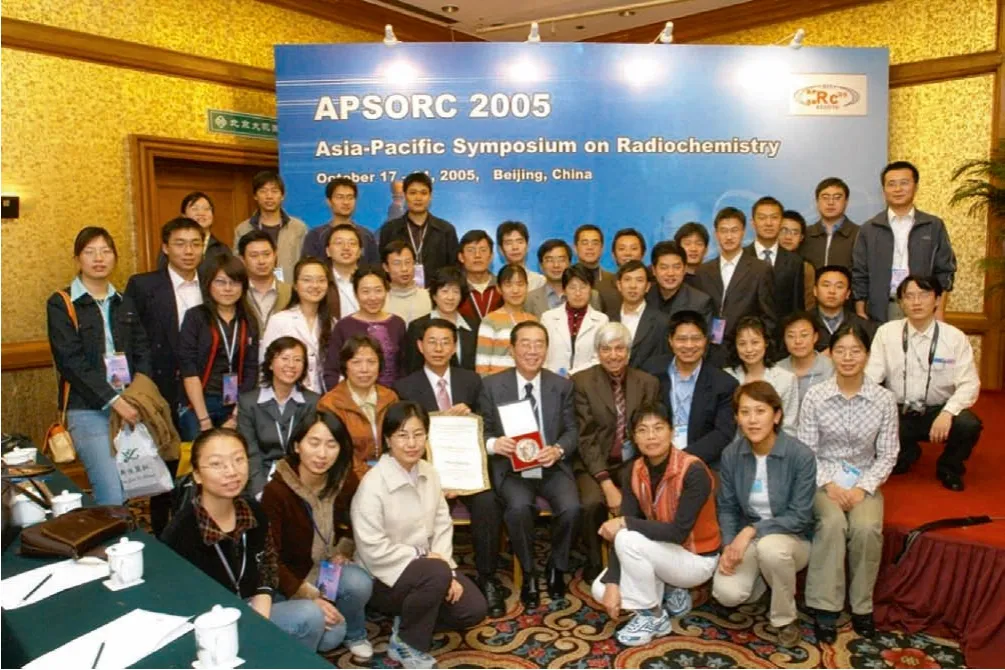
Prof.Zhifang Chai received the George Hevesy Medal at APSORC 2005 in Beijing,China, 2005.
1.1.Platinum-group elements
Platinum-group elements (PGEs) such as Ir and Pt are often used as tracers of extraterrestrial indicators in geochemistry and cosmochemistry and the chemical species of PGEs are associated with their origin.
Prof.Chai and colleagues developed several methodologies for the sensitive and accurate determination of PGEs in geological boundary samples, marine sedimentary samples, as well as meteorites, ultrabasic rocks, volcanic lava and dinosaur egg fossil samples [3,6–10].One of his prominent work using NAA in geochemistry and cosmochemistry is the discovery of Ir anomaly at Cretaceous-Tertiary (K-T), Permian/Triassic (P-Tr), Devonian/Carboniferous D/C boundaries [6,11], which provided the direct evidence for an extraterrestrial impact event to the earth.Prof.Chai and colleagues confirmed that the anomalous Ir of the K-T boundary mainly originated from the extraterrestrial matter while the organic matter from microorganisms influenced the enrichment of Ir at the K-T boundary in marine sediments.Moreover,the Ir enrichment by secondary geochemical processes was probably due to the decomposition of extraterrestrial debris and dust formed at the impact event [3,7].
1.2.Rare earth elements
The wide use of rare earth elements (REEs) in different sectors like green energy and military technologies leads to the contamination of the surrounding environment, which causes adverse effects to human health.
From 1990s, Prof.Chai and colleagues studied the biological effects of REEs in plants and animals.InDicranopteris dichitoma,a hyperaccumulator of REEs, the REE bound proteins, polysaccharides, and DNA were identified for the first time [12,13].In animal studies, the enriched stable isotope tracers (152Sm and168Yb) combined with NAA and differential centrifugation were utilized to investigate their subcellular distribution in rat liver.Based on these works, the highest contents of Sm and Yb in mitochondria while the lowest in nuclei were found [14].
With the support of a major research project on "Toxicological studies of typical environmental pollutants at the molecular level using nuclear analytical techniques" funded by National Natural Science Foundation of China with Prof.Chai as the leading scientist, it was found that the concentration of153Sm and169Yb in the brain was much higher than that in blood, which proved that REEs could enter the brain and remain in the brain for long time [15,16].Further studies found that the chronic exposure to La and Yb could impair the learning ability of animals with a new mechanism on the neurotoxicology of REEs,i.e., [Ca2+]i/Ca2+-ATPase homeostasis, antioxidant enzymes, and LPO were influencedviaan indirect,multistep mechanism under a long-term exposure to REEs [17–23].These studies helped a lot in the understanding of the decline of the mental age and intelligence quotients of the children living at the high-REEs regions.
1.3.Mercury
Mercury (Hg) is one of the most toxic heavy metals, which can migrate around the globe and magnify through the food chain,thus harming human health.It can be released to the environment through natural processes like volcanic eruptions and wild fires, or anthropogenic activities like burning of fossil fuels, waste incineration, metal mining and smelting, and industrial dischargeetc.In China, there were some hot spots of Hg contamination such as the Second Songhuajiang river system and Wanshan mercury mine area due to industrial discharge and Hg mining.
Using NAA together with other techniques like synchrotron radiation based ones, Prof.Chai is one of the pioneered scientists who studied Hg in glaciers from the first scientific expedition on the Qinghai Tibet Plateau in 1970s [24].Since 1990s, Prof.Chai and colleagues studied the total and methyl Hg levels in different environmental and biological matrixes like human beings [25–33], animals [34–40] and plants [41,42] in both the Second Songhuajiang river system and Wanshan mercury mine area.Furthermore, the antagonism of selenium (Se) with Hg was discovered in the studied areas [33,35–37,40,43–47].These findings laid a well basis for the application of Se in health promotion for Hg-exposed residents[48,49] and quality assurance of crops grown in Hg-contaminated farmlands [50–54], which provided effective ways in combating Hg contamination.Besides field studies, laboratory works helped a lot in the elucidation of the mechanism on the toxicity of Hg [54–59], especially the bioavailability and methylation potential of HgS[57,60], which was previously regarded as the sink of Hg.
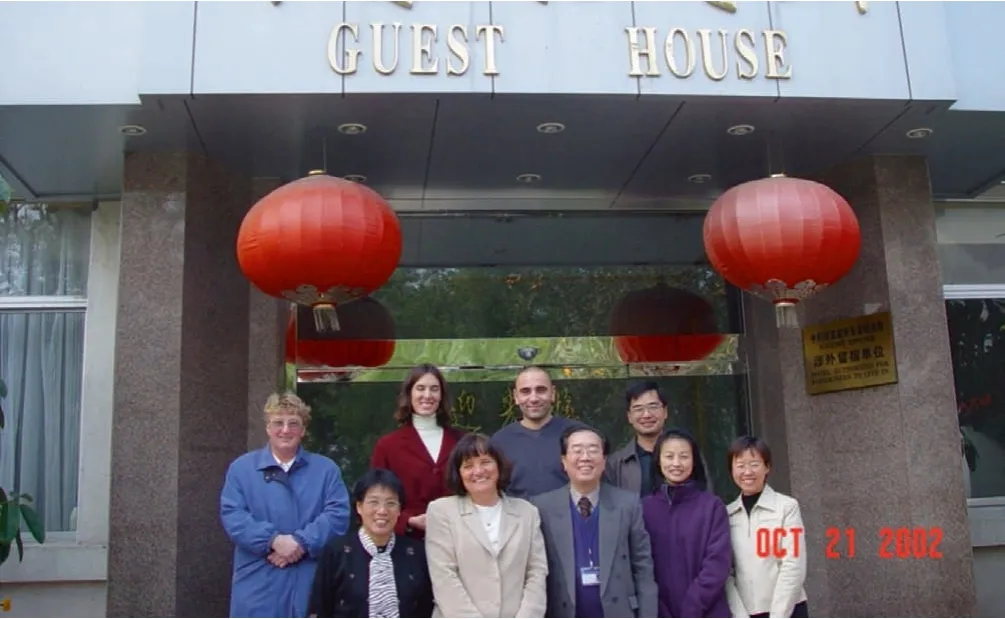
Prof.Zhifang Chai and his Slovenian counterpart Prof.Milena Horvat and colleagues in 2002.
From 1990s, Prof.Chai and colleagues led several international projects on Hg, including the Coordinated Research Projects (CRPs)of International Atomic Energy Agency (IAEA) and the sixth Framework Program of European Union,etc., which greatly enhanced both knowledge exchanges and personnel training.
Prof.Chai also co-led a policy study named “Special policy study on mercury management in China” with domestic and international experts in 2010.The report was submitted to State Council of China through China Council for International Cooperation on Environment and Development in 2011 [61].This report provided a ten-point action plan, including actions in seven industrial sectors, and offered four recommendations for priority actions on the management of Hg in China, which provided strong supports for the following governmental negotiation and implementation of Minamata Convention on Mercury.
1.4.Organic halogens
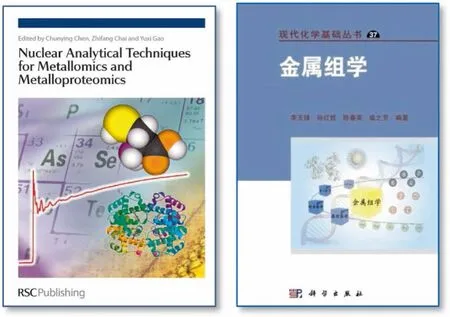
Prof.Zhifang Chai and colleagues published the first English and Chinese books on metallomics in 2010 and 2016, respectively.
Organic halogens like polychlorinated biphenyls, hexachlorobenzene and organochlorinated pesticides (OCPs) such as hexachlorocyclohexanes (HCHs), dichlorodiphenyl trichloroethane(DDT) and its metabolites are persistent and bioaccumulative.They pose great environmental hazardous effect and were regulated by Stockholm Convention on Persistent Organic Pollutants.
From 2000s, Prof.Chai and colleagues studied organic halogens in pine needles to evaluate the contamination of organic halogens in the atmospheric environment using NAA and GC/MS [62–65].They found that HCB and DDT were linked to the economic development for the first time.Besides, Prof.Chai and colleagues found that the level of the extractable organic halogens in foodstuff was also highly correlated to the development status of the regions[62].
Aerosols sample is another carrier of organic halogens studies.Prof.Chai and colleagues performed long-term measurements of organic halogens in aerosols in Beijing city and other places in China using both passive and active air samplers.Long-term changes and atmospheric residence times of organic halogens,their sources and deposition flux, and regional emission patterns in Beijing city were deduced and localized hotspots in China was highlighted.Prof.Chai and colleagues also studied the levels of organic halogens in fine and ultra-fine particles and the risks were assessed [66].All these efforts contributed to the effectiveness evaluation of the implementation of the Stockholm Convention on Persistent Organic Pollutants in China.
2.The pioneered work in NATs based metalloproteomics and metallomics
Metallomics is a research field to systematically study the interactions and functional connections of metallome with genes,proteins, metabolites and other biomolecules within organisms[67,68].
Prof.Chai contributed a lot in this emerging research field as an IUPAC member including defining the terminology of metallomics[69].He also serves as the editorial member and advisory member of the flagship journal of metallomics,i.e., Metallomics.He is the steering committee member of International Symposium on Metallomics (ISM) since the first meeting in 2007 and the scientific board member of Chinese national symposium on metallomics(NSM).In 2015, Prof.Chai co-hosted the 5thInternational Symposium on Metallomics in Beijing with Prof.Xinrong Zhang at Tsinghua University.
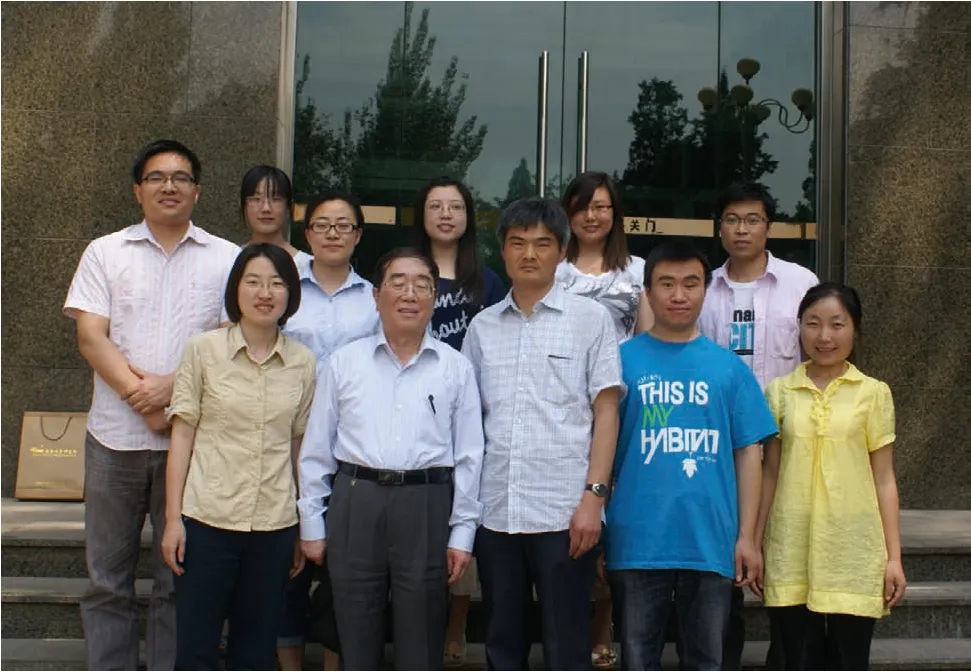
Prof.Chai and colleagues at Institute of High Energy Physics, CAS in 2011.
The multielemental detection nature of NATs makes them versatile tools for metallomics studies.Prof.Chai, Chunying Chen and Yuxi Gao edited the first English book on metallomics and metalloproteomics,i.e.,“Nuclear Analytical Techniques for Metallomics and Metalloproteomics” by RSC publishing in 2010 [70] and the first Chinese one,i.e.,“Metallomics” by Science Press in China in 2016[71].In fact, the above-mentioned study on interaction of Hg with Se and other elements is a typical example among metallomics studies [2–4,32,34–37,39–41,43–45,72–83].His collaborative work on metallomics with Prof.Hongzhe Sun at The University of Hong Kong also contributed to the establishment of the CAS-HKU Joint laboratory of metallomics on health and environment [84,85].
NATs also serve well in other emerging scientific areas like the biological effects and safety of engineered nanomaterials.Prof.Chai and colleagues are the pioneered scientists in studying the biological effects and safety of engineered nanomaterials through NATs,which contributed to the establishment of the first laboratory focused on the biomedical effects of nanomaterials and nanosafety in China [79,81,86–89].Prof.Chai and colleagues put forward the first branch of metallomics,i.e., nanometallomics [70,90,91].Nowadays, more branches of metallomics like environmetallomics and agrometallomics were put forward [92], suggesting the versatile roles of NATs based metallomics in different research areas.For example, in medical science, the distribution of Fe, Cu, Zn, Ca in the brain of transgenic rats with Alzheimer’s disease and the enrich ratio of the mineral elements with Aβ42 peptide were investigated through spatial metallomics [93–95].Furthermore, isotope dilution and ICP-MS contributed to the single cell metallomics analysis [96–99].
3.The pioneered work in nuclear-energy radiochemistry
3.1.Solid state chemistry of actinides
Since 2014, Prof.Chai and colleagues pioneered the novel applications of actinide-containing compounds.Metal-organic frameworks containing early actinides from thorium to americium were synthesized, which exhibited outstanding radiation stability and excellent remediation capacity for key pollutants generated in the nuclear industry [100–102].In addition, a series of plutonium compounds in uncommon oxidation states such as Pu(V) and Pu(III)were discovered [103].
Prof.Chai and colleagues introduced supramolecular chemistry into actinide chemistry [104–108].They proposed a new paradigm for actinide separation based on actinide coordination assembly of nanoclusters for enhancing the separation efficiency of actinide cations.They also systematically developed a series of pseudorotaxane ligands for actinide supramolecular chemistry exploration and effective separation and immobilization of transuranic elements.More importantly, supramolecular materials with rich binding sites were used for solid-phase recognition and separation of actinides and technetium.
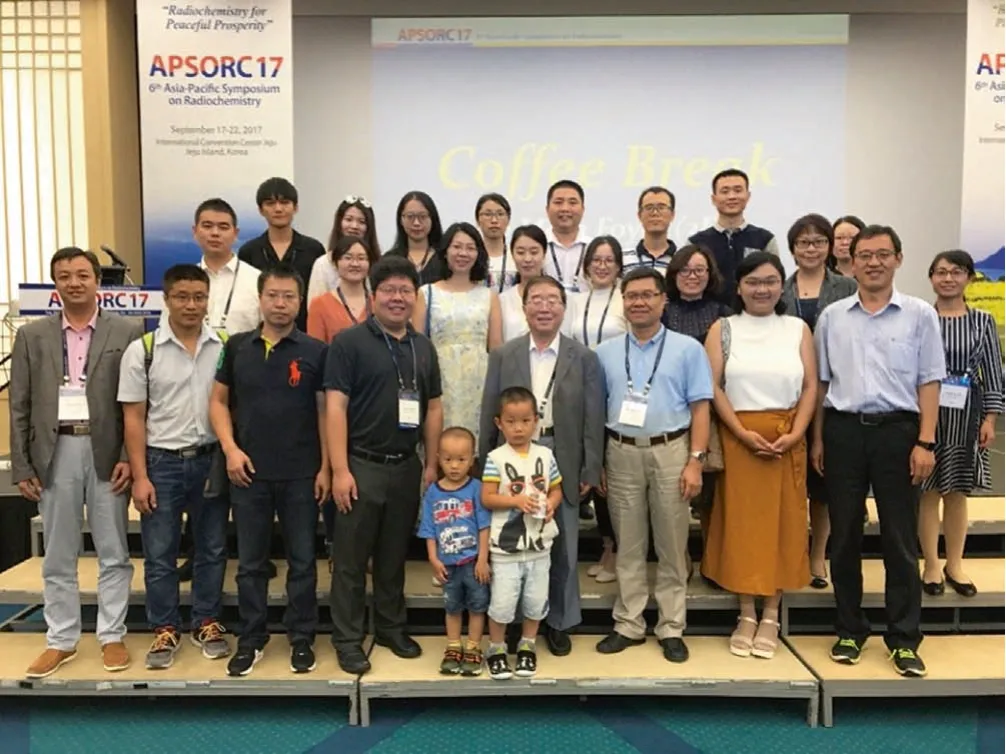
Prof.Zhifang Chai and colleagues at the 6th Asia-Pacific Symposium on Radiochemistry in Jeju Island, Korea, 2017.
3.2.Radiochemical separation
Since 2010, Prof.Chai and co-workers committed to develop advanced solid and liquid phase extraction techniques for radiochemical separation.They pioneered the environmental remediation of various radionuclides with functional nanoporous adsorbents including metal-organic frameworks (MOFs) and covalent organic frameworks (COFs) [109–111].A series of stable MOFs, COFs and cationic polymeric networks (CPNs) were reported with superior adsorption capacities, kinetics, and selectivity for99TcO4-/ReO4-[112–115].Two base-resistant adsorbents can directly remove99TcO4-from simulated alkaline nuclear waste solution with high distribution coefficients [116,117].They unraveled the adsorption mechanismviathe structural illustration of the TcO4--incorporated single crystal [118].They also provided a rare capture strategy for uranyl combined with complexation, chemical reduction, and photocatalytic reduction [119,120].In addition,a layered coordination polymer can selectively remove Sr2+from seawater with the aid of the donor atoms in adjacent layers [121].They also developed several adsorbents for gaseous nuclides [122].
Separation of actinides from high-level liquid waste (HLLW)was one of the challenges in spent fuel reprocessing.Prof.Chai and colleagues developed a series of efficient tetradentate phenanthrolineamide (DAPhen) ligands for group separation of actinides based on a hard-soft donor combined strategy [123–127].Novel efficient liquid-liquid extraction systems based on the hard-soft donor combined ligands for group separation of actinides over lanthanides were established.A series of functionalized nanomaterials for highly efficient separation of U(VI) and Th(IV) from aqueous solution were developed [128].
In dry reprocessing of spent nuclear fuels, one great challenge is to increase the separation factor of actinides in molten salt.Prof.Chai and colleagues efficiently separated and recovered actinides based on a solid active aluminum cathode [129,130].They also established anin-situanodic precipitation (IAP) method to separate actinides from aluminum in a low-temperature molten salt [131].
3.3.Novel radiation detection materials
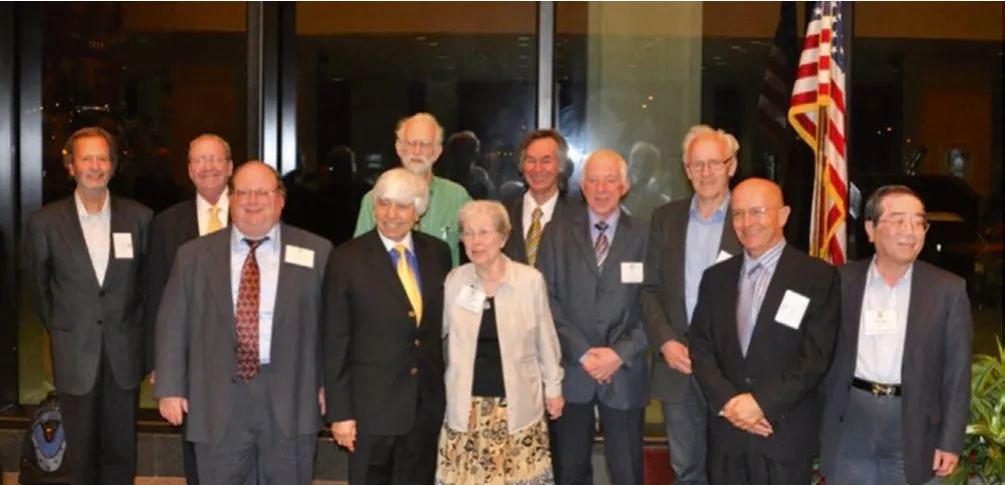
Prof.Chai and the George Hevesy Medal recipients of different years at MTAA-13 in TX, USA, 2011.
Since 2017, Prof.Chai and colleagues pioneered the research of inorganic-organic hybrid crystalline material for radiation detection.They designed a series of metal-organic frameworks(MOFs), metal-organic cages (MOCs) and metal-organic clusters,and demonstrated their potentials for X-ray detection and X-ray imaging.Uranium-bearing compounds were proven to be advanced radiation dosemeters, scintillators, and green-emitting phosphors[132–134].
Prof.Chai and colleagues reported the seminal work on the direct radiation detection using a semiconductive MOF with the Xray detection sensitivity of 23.8 μC Gyair-1cm-2, which is on a par with that of commercially-available amorphous selenium (a-Se) detector [135–138].
The intrinsic advantages of uranyl endow them high sensitivity and luminescence efficiency.Furthermore, the intrinsic large X-ray attenuation coefficient over high energy photons of actinide elements was harnessed to construct new semiconducting materials for X-ray detection [136,139].
3.4.Actinide decorporation agents
Since 2015, Prof.Chai and colleagues also focused on the development of decorporation agents with low toxicity and high efficiency to promote the therapeutic effect in nuclear emergency treatment.
New actinide decorporation agents were synthesized with significantly elevated actinide removal efficacy.The uranyl removal efficacy from bones was increased by almost six folds, providing a potential solution to the long-term difficulty of bone decorporation [140,141].Nano-decorporation agents were prepared by combining the nanoparticles that can eliminate ROS, and the effect of “decorporation+protection” was achieved, further reducing the radiation damage caused by internal radiation [142].Nanomaterials such as Covalent Organic Nanosheets (CONs) were utilized for actinide decorporation by taking the advantage of the steric arrangement of binding sites in the confined space,and the removal ratio was significantly increased compared to the molecular decorporation agents using the same functional group [143].
4.Honors and awards
Due to his great contributions in the field of NATs, especially neutron activation analysis (NAA) and nuclear-energy radiochemistry, Prof.Chai was highly recognized domestically and abroad.Selected awards are listed as followings:
1978,Measurements of excitation curves for the reactions of fast neutron with some nuclides, National Science Award (the fourth awardee).
1978,Study of protection of the Guanting reservoir water system,National Science Award (the third awardee).
1983,Comprehensive research on the Jing-Jin-Bo region, The Second Prize of National Science and Technology Progress Award (the sixth awardee).
1988,The application of nuclear analytical techniques in environmental monitoring,The Second Prize of National Science and Technology Progress Award (the first awardee).
1991,Platinum-Group Element Abundance Patterns, The First Prize of Natural Science Award of Chinese Academy of Sciences(the first awardee).
1999,Molecular neutron activation analysis for several important elements, The second Prize of Natural Science Award of Chinese Academy of Sciences, (the fifth awardee).
2005, George Hevesy Medal Award.
2007, Member of the Chinese Academy of Sciences.
2012, The Second Prize of National Prize of Natural Sciences(the fifth awardee).
2015, Lifetime Achievement Award for Analytical Atomic Spectrometry in China.
2019, The Chinese Academy of Sciences Outstanding Achievement Award.
We wish Professor Chai a very happy 80thbirthday and many more years of good health and productive radioanalytical chemistry.
Yuliang Zhao*, Chunying ChenCAS Key Laboratory for Biological Effects of Nanomaterials and Nanosafety & CAS Center for Excellence in Nanoscience, National Centre for Nanoscience and Technology, Beijing 100191, China
Weiyue Feng, Zhiyong ZhangCAS Key Laboratory for Biological Effects of Nanomaterials and Nanosafety & CAS-HKU Joint Laboratory of Metallomics on Health and Environment & Beijing Metallomics Facility, Institute of High Energy Physics, Chinese Academy of Sciences, Beijing 100049, China
Diandou XuDivision of Research and Planning, Institute of High Energy Physics,Chinese Academy of Sciences, Beijing 100049, China
Weiqun ShiLaboratory of Nuclear Energy Chemistry, Institute of High Energy Physics, Chinese Academy of Sciences, Beijing 100049, China
Shuao WangState Key Laboratory of Radiation Medicine and Protection, School for Radiological and Interdisciplinary Sciences (RAD-X) and Collaborative Innovation Center of Radiation Medicine of Jiangsu Higher Education Institutions, Soochow University, Suzhou 215123,China
Yu-Feng LiCAS Key Laboratory for Biological Effects of Nanomaterials and Nanosafety & CAS-HKU Joint Laboratory of Metallomics on Health and Environment & Beijing Metallomics Facility, Institute of High Energy Physics, Chinese Academy of Sciences, Beijing 100049, China
*Corresponding author.
E-mail address:zhaoyl@nanoctr.cn (Y.Zhao)
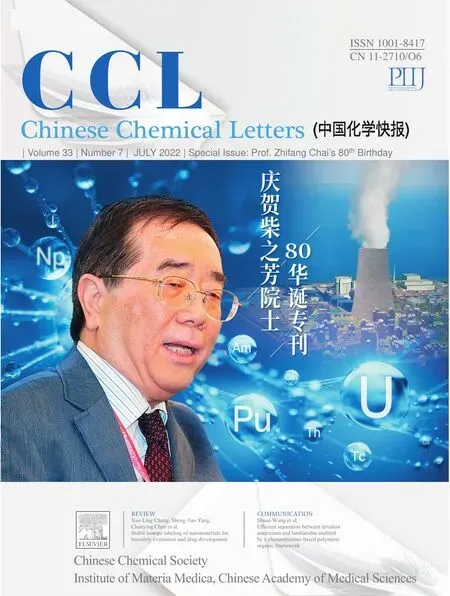 Chinese Chemical Letters2022年7期
Chinese Chemical Letters2022年7期
- Chinese Chemical Letters的其它文章
- Stable isotope labeling of nanomaterials for biosafety evaluation and drug development
- Emerging nanozymes for potentiating radiotherapy and radiation protection
- Recent progress of astatine-211 in endoradiotherapy: Great advances from fundamental properties to targeted radiopharmaceuticals
- Recent development in selective Tau tracers for PET imaging in the brain
- 64Cu radiolabeled nanomaterials for positron emission tomography(PET) imaging
- Radiolabeled peptide probe for tumor imaging
